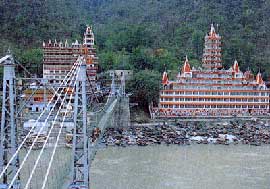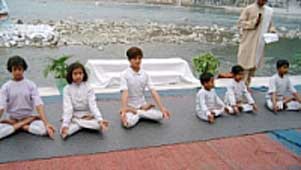For Packages of Rishikesh Click Here
RISHIKESH
A Pilgrim’S Progress
 The Garhwal region of north India is speckled with some of the holiest of Hindu pilgrimage sites and Rishikesh is one such major attraction. Crowded with sadhus with long matted hair and pilgrims from all over the globe, Rishikesh is the birthplace of yoga. It attracts thousands of tourists every year, who come to seek mental peace in the midst of the humdrum of modern life. The various ghats and temples assist the human spirit in its endeavor to be one with the ultimate source of all creations. It is also an attraction for the ones in search of adventure and passion.
The Garhwal region of north India is speckled with some of the holiest of Hindu pilgrimage sites and Rishikesh is one such major attraction. Crowded with sadhus with long matted hair and pilgrims from all over the globe, Rishikesh is the birthplace of yoga. It attracts thousands of tourists every year, who come to seek mental peace in the midst of the humdrum of modern life. The various ghats and temples assist the human spirit in its endeavor to be one with the ultimate source of all creations. It is also an attraction for the ones in search of adventure and passion.
LOCATION
Rishikesh is located in the northern part of Uttar Pradesh. It is 238 km northeast of Delhi and 24 km north of Haridwar and spreads on the right banks of the Ganges, at its confluence with the Chandrabhaga stream. It is surrounded by hills on three sides and is perched at an altitude of 356 meters above sea level. The name Rishikesh is loosely applied to an association of five distinct sections encompassing not only the town but also hamlets and settlements on both sides of the river. These include Rishikesh itself, the commercial and communication hub; the sprawling suburban Muni-ki-Reti or the “sands of the sages”; Shivananda Nagar, north of Rishikesh; the temple section of Lakshmanjhula, a little further north; and the assorted ashrams around Swarg Ashram on the east bank. In Rishikesh, the winters last from November to March, when temperatures fall below 0°C. The monsoons are generally experienced in the months of July and August.
THE PAST
Legend has it that the sage Raibhya Rishi did severe penance and, as a reward, God appeared to him in the form of Hrishikesh. Rishikesh also represents the site where Lord Vishnu vanquished the demon Madhu. The place is known as the Tapo Bhumi or the place for meditation of the Gods. Tapovan, on the other bank of the Ganges, houses a temple to Lakshmana. It is believed that Lakshmana, the younger brother of Lord Rama, carried out penances here. The Neelkanth Mahadev temple is believed to be the site where Lord Shiva had drunk the venom that came out during the churning of the ocean. In the 1960s, the place came into limelight as the place where the pop group Beatles met their guru, Maharishi Mahesh Yogi.
TOURIST ATTRACTIONS
Rishikesh abounds in temples. Most of the pilgrims who pass through Rishikesh on their way to the Himalayan shrines of the Char Dham pause for a holy dip and puja at Triveni Ghat, in the central part of the town. The river here looks especially spectacular during aarti (evening worship) when diyas or oil lamps float on the water. Nearby is the Bharat Mandir, Rishikesh's oldest temple, dedicated to Lord Vishnu.
The Chandreshwar temple stands at the confluence of the Chandrabhaga and the Ganges. The Hanuman Mandir is flocked by a large number of devotees on Tuesday.
The dense-knit complex of cafés, shops and ashrams collectively known as Swarg Ashram, opposite Shivananda Nagar, is the most attractive part of Rishikesh, backing on to forested hills where caves are still inhabited by sadhus or hermits. The large courtyard of the Parmarth Ashram here is crammed with brightly clad statues of gods and goddesses. Around 2 km north of Swarg Ashram, a path skirts the east bank of the river en route to Lakshman Jhula. The Lakshman Jhula is a 450-feet-long suspension bridge and was built in 1939. The Lakshman Temple on the west bank has been built to commemorate the journey of Lakshmana across the river on a jute rope. Many of the temples and ashrams around both ends of the bridge—such as the extraordinary Kailashananda Ashram, with each of its thirteen stories dedicated to a different deity—are always filled with devotees. It is a pleasant 2-km walk from this place to the Shivananda Jhula. Ganga Museum has one of the richest collections of Mughal and Rajput paintings of the 18th and 19th centuries. The tomb of Fateh Jang, built in honour of one of Shahjahan’s ministers, combines Islamic and Hindu architectural features. The Jaisamand Lake is a large artificial lake constructed by Maharaja Jai Singh in 1910 and makes an excellent picnic spot. The Vijay Mandir Palace is the royal residence of Maharaja Jai Singh, uninhabited except for old retainers. This palace serves as a window to the lifestyle of the princes.
SITES NEARBY
The Vilas Vinay Palace, about 10 km from the main township, is a garden palace and was once the residence of Maharaja Vinay Singh. Its gardens are watered by the Silisehr Lake. There is a hunting lodge on the hillside overlooking the lake and it has been now turned into a hotel.
Fifteen kilometers on the Rishikesh–Chamba road is located the historical town of Narendra Nagar. A town of archaeological importance, it was built by the King of Tehri, Narendra Singh. The royal palace here is worth seeing as is the magnificent statue of Lord Shiva’s attendant, the Nandi bull.
Rajaji National Park at Chilla is 16 km from Rishikesh. The park (820 sq km) has wildlife in abundance and is especially known for its wild elephants. The Sariska sanctuary is 37 km from Rishikesh. It was established in 1955 and is located in the valley of the Aravallis.
The Nilkanth Mahadev, east of Rishikesh, is one of the holiest shrines here. The beautiful forest track rises through the forests behind Swarg Ashram, passes Mahesh Yogi's ashram, and eventually descends to Nilkantha, which is at an altitude of 1700 meters. Its small bazaar and dharamshala become especially animated during mid-July, when pilgrims flock to the temple.
The small white Shakti temple of Kunjapuri is 10 km higher at the sharp point of an almost perfectly conical hill with breathtaking views of the Himalayas to the north.
MEDITATION AND YOGA CENTERS
 Rishikesh is called the yoga capital of the world and there are many ashrams in Rishikesh offering courses on meditation, yoga and Hindu philosophy. The hatha yoga and pranayama meditation classes at Sri Ved Niketan Ashram are well known.
Rishikesh is called the yoga capital of the world and there are many ashrams in Rishikesh offering courses on meditation, yoga and Hindu philosophy. The hatha yoga and pranayama meditation classes at Sri Ved Niketan Ashram are well known.
SHOPPING
Being a pilgrimage place, the glamour of big shop bargains is absent, but Rishikesh offers handicraft items made of shells, beads and pearls. The rudraksha mala or the Hindu rosary is a special attraction here. Saris, kurtas, sheets and rugs can be purchased from here. One can buy these items from the government-approved UP handloom shop, Khadi Bhandar. The main shopping centers in the city are Dehradun Road, Haridwar Road, Ghat Road and Railway Road. The city center also has some state emporia. A good range of Ayurvedic medicines made from Himalayan herbs are available at Maharishi Mahesh Yogi Ayurvedic Center.
HOW TO REACH
By Air Jolly Grant airport (35 km) is serviced by limited flights from Delhi.
By Rail Haridwar (35 km) is the nearest railhead well connected to rest of the country.
By Road Rishikesh is connected by bus via Haridwar with Agra, Chandigarh, Dehradun, Kullu, Manali, and Shimla. It is also linked to Mussourie (77 km), Badrinath (301 km), Kedarnath (228 km), Gangotri (258 km), Yamunotri (288 km), Srinagar (105 km), and Joshimath (252 km). There are two bus stands, the Main Bus Stand and the Yatra Bus Stand.